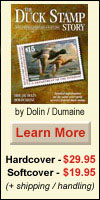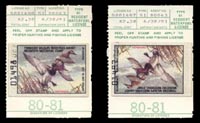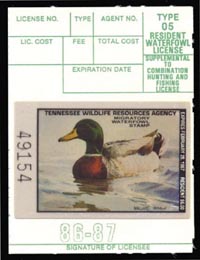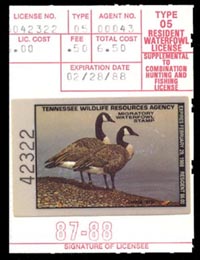 |
10% off on
web orders over $100 |
|
|

|
|
Invert variety of Tennessee duck stamp discovered
Perhaps the most intriguing of stamp errors is the invert, where one portion of the design is upside down in relation to the rest of the image.
Many collectors eagerly seek inverts, and excitement often follows a new discovery. A single invert error of the 1980-81 Tennessee $2 Canvasbacks duck stamp (Scott 3), with the entire design inverted in relation to the serial number printed on the stamp, has come to light.
The stamp is still affixed to the original resident waterfowl license receipt card, as shown in Figure 1, left. A normal Canvasbacks stamp is affixed to the card shown at right. The lucky collector who made the discovery wishes to remain anonymous. He intends to keep the stamp in his own collection. The collector also owns the card bearing the normal Canvasbacks stamp.
Instructions on both cards direct the customer to "peel off stamp and apply to proper hunting and fishing license." The heretofore unreported error surfaced some 21 years after the stamp was issued. It is the first of its kind to come to my attention.
When the owner showed me the item, I thought it was a fluke - someone had simply peeled the stamp off the license and reaffixed it upside down. A closer look revealed that the printed serial number on the error stamp, "01497," was applied correctly on the left side of the stamp, reading from bottom to top.
This also is the case for serial No. 01498 on the normal stamp shown here. Note that the serial numbers on the stamps match the last five digits of the seven-digit license number printed in the top-left corner of each card.
Tennessee self-adhesive duck stamps of the 1980s were mechanically affixed to three-part cards from coil rolls. The error may have occurred when a roll of printed Canvasbacks stamps was mounted incorrectly to the machine that applied the serial numbers to the stamps and then affixed them to the cards.
Other possible scenarios exist, but this seems the most likely. Given that the Canvasbacks stamp bearing serial No. 01498 is normal, a machine failure may have dictated removal of the roll from the machine that printed the serial numbers. Perhaps the incorrect orientation of the roll was subsequently discovered, and the roll was then remounted in the machine.
Canvasbacks stamps bearing serial numbers prior to No. 01497 were not available for inspection. Tennessee is no stranger to printing mistakes on its duck stamps.
Improperly oriented serial numbers exist, as demonstrated by the 1986-87 $6 Mallard stamp affixed to the card shown in Figure 2. The serial number is on the left side of the stamp, where it belongs, but it reads from top to bottom rather than from bottom to top.
This may have been caused by an improper machine adjustment or something similar. Top-to-bottom serial numbers also exist for the $15 Mallard of 1994 and the $17 Black Ducks of 1996. Mistakes also are known on the license receipts themselves, as on the license pictured in Figure 3.
The $6 Canada Geese 1987-88 license receipt bears an expiration date of Feb. 28, 1988, instead of the correct leap year date of Feb. 29, 1988. Only a few such cards were printed and released with the incorrect date. These unusual varieties are due to the extra steps taken to produce Tennessee duck stamps and the associated licenses.
Most other states simply print, double-check and release their duck stamps. Tennessee, however, prints the stamps and then sequentially numbers them in a separate operation. This magnifies the possibility for mistakes. It seems that inconsistency is the only constant for Tennessee duck stamps.
o
The 2001 American Philatelic Society Stampshow, held Aug. 23-26 in Rosemont, Ill., a suburb of Chicago, was a boost for duck stamps. The show was a beehive of activity, and I certainly hope it will be that way when Stampshow moves to Atlantic City, N.J., next year.
June Berwald's exhibit "Saluting America's Wildlife Artists" won an APS vermeil medal, an American Revenue Association gold award, and the National Duck Stamp Collectors Society's conservation award. The Duck Stamp Story, co-authored by Eric Jay Dolin and me, received an APS literature gold medal. Naturally, Eric and I were both elated to receive this honor for our work, especially because gold medals for literature are somewhat elusive. The book was published in 2000 by Krause Publications.
o
The United States federal duck stamp office is experiencing major change. Robert C. Lesino, chief of the duck stamp office, accepted a new assignment with the Treasury Department in California in mid-September. Lesino certainly will be missed in many areas of the duck stamp effort.
Lesino began artist workshops, held in various areas of the country, to help artists competing in the federal duck stamp contest. Adam Grimm, winner of the 1999 contest, was a product of such a workshop. Many other artists who catapulted into the top group of finishers in other years also were workshop veterans.
Under his watch, the junior duck stamp program expanded to cover all 50 states, Washington, D.C., and five U.S. possessions. Enthusiasm for the program (and wildlife art in general) has spread from young people of all ages to their families, broadening the support base for duck stamps.
I bid a fond farewell to Bob Lesino, a fixture at stamp shows nationwide, who generously gave his time, effort and advice to collectors, dealers, artists, sportsmen, birdwatchers and our youth. Good luck, Bob. Another loss to the duck stamp program is Georgia Bednar, who handled most of the mail-order activity at the duck stamp office.
Georgia was a great asset to collectors. She took the extra time to please, and she was especially helpful to me, always going the extra mile and providing information for this column. I hope her path of progression will lead her back to duck stamps at some point.
Terry Bell, longtime duck stamp office veteran, is now acting chief, replacing Lesino. The timing couldn't be worse for Terry, because the federal duck stamp contest is being held Nov. 6 in Washington, D.C.
However, she is extremely capable and up to the challenge. I'm positive. With so many changes, collectors can expect some minor bumps until everyone is comfortable with their new assignments.
I know the folks at the duck stamp office will appreciate some patience and understanding. For more details, see the story in Linn's issue of Sept. 17, page 15.
--------------------------------------------------------------------------------

Figure 1. Unusual invert variety of the 1980-81 Tennessee $2 Canvasbacks duck stamp, left, affixed to a hunting license receipt card. A normal stamp, also on card, is shown at right.
--------------------------------------------------------------------------------

Figure 2. The serial number on this Tennessee duck stamp belongs in the left margin, as shown, but the number should read from bottom to top, not top to bottom.
--------------------------------------------------------------------------------

Figure 3. The year 1988 was a leap year. The expiration date on this Tennessee hunting license receipt should read "02/29/88," not "02/28/88," as printed just above the stamp. |
|
|



















